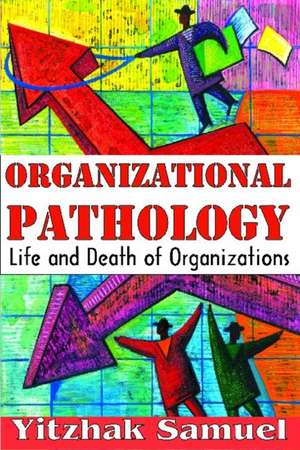Organizational Pathology: Life and Death of Organizations
Autor Yitzhak Samuelen Limba Engleză Paperback – 15 feb 2012
Organizational Pathology draws an extended metaphor that the life cycle of an organization is akin to the biological life cycle. Like all living things, organizations will encounter problems that lead to decline and eventual failure. This work discusses the basic problems and life threatening diseases responsible for organizations' failure and death, including organizational politics, organizational corruption, and organizational crime. The book also contains a critical look at crises and fixations; failure and survival; and processes of disbandment and closure of dying organizations.
The consideration of these issues follows a diagnostic model of failure. Yitzhak Samuel argues that if the problems that lead to failure can be predicted or diagnosed early, their severity can be assessed and possible remedies can be implemented to avoid escalating crises. At the very least, an understanding of why and how decline happens can be gained from this analysis. This book offers facts about the causes and consequences of organizational downfall and clues about diagnoses of certain symptoms of abnormal behavior, and how to identify early signs of decline or failure. In order to illustrate these abstract arguments and concepts, Samuel uses various real-life examples of events that have occurred in cross-country contexts. In this way, Organizational Pathology: Life and Death of Organizations should serve a variety of readers.
Although primarily intended for students and scholars in the social and behavioral sciences who are familiar with the study and the practice of organizations, this book's informal style makes it easily accessible to a wide range of readers. Just as Samuel's previous book on organizational politics led to new lines of research and theory, this book will encourage similar studies in organizational pathology and institutional malaise.
| Toate formatele și edițiile | Preț | Express |
|---|---|---|
| Paperback (1) | 308.65 lei 43-57 zile | |
| Taylor & Francis – 15 feb 2012 | 308.65 lei 43-57 zile | |
| Hardback (1) | 1106.41 lei 22-36 zile | +20.62 lei 6-12 zile |
| Taylor & Francis – 14 sep 2017 | 1106.41 lei 22-36 zile | +20.62 lei 6-12 zile |
Preț: 308.65 lei
Preț vechi: 362.26 lei
-15% Nou
59.08€ • 64.19$ • 49.66£
Carte tipărită la comandă
Livrare economică 21 aprilie-05 mai
Specificații
ISBN-10: 141284584X
Pagini: 188
Dimensiuni: 152 x 229 x 10 mm
Greutate: 0.27 kg
Ediția:1
Editura: Taylor & Francis
Colecția Routledge
Locul publicării:Oxford, United Kingdom
Cuprins
Descriere
Organizational Pathology draws an extended metaphor that the life cycle of an organization is akin to the biological life cycle. Like all living things, organizations will encounter problems that lead to decline and eventual failure. This work discusses the basic problems and life threatening diseases responsible for organizations' failure and death, including organizational politics, organizational corruption, and organizational crime. The book also contains a critical look at crises and fixations; failure and survival; and processes of disbandment and closure of dying organizations.
The consideration of these issues follows a diagnostic model of failure. Yitzhak Samuel argues that if the problems that lead to failure can be predicted or diagnosed early, their severity can be assessed and possible remedies can be implemented to avoid escalating crises. At the very least, an understanding of why and how decline happens can be gained from this analysis. This book offers facts about the causes and consequences of organizational downfall and clues about diagnoses of certain symptoms of abnormal behavior, and how to identify early signs of decline or failure. In order to illustrate these abstract arguments and concepts, Samuel uses various real-life examples of events that have occurred in cross-country contexts. In this way, Organizational Pathology: Life and Death of Organizations should serve a variety of readers.
Although primarily intended for students and scholars in the social and behavioral sciences who are familiar with the study and the practice of organizations, this book's informal style makes it easily accessible to a wide range of readers. Just as Samuel's previous book on organizational politics led to new lines of research and theory, this book will encourage similar studies in organizational pathology and institutional malaise.


























